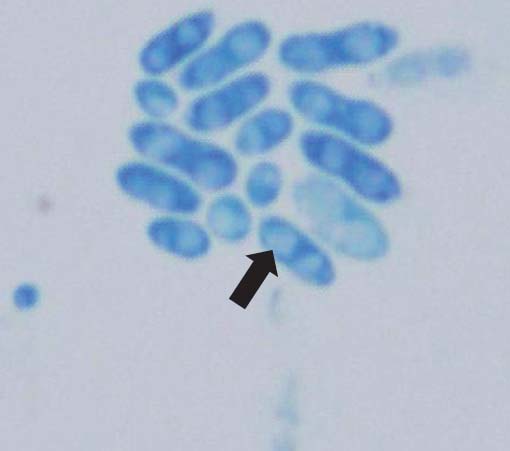Infect Chemother.
2012 Dec;44(6):477-480. 10.3947/ic.2012.44.6.477.
Two Cases of Saccharomyces cerevisiae Fungemia in Patients with Hematologic Malignancies
- Affiliations
-
- 1Department of Internal Medicine, College of Medicine, The Catholic University of Korea, Seoul, Korea. symonlee@catholic.ac.kr
- 2Division of Infectious Diseases, Department of Internal Medicine, Ilsan Hospital, Goyang, Korea.
- 3Department of Laboratory Medicine, College of Medicine, The Catholic University of Korea, Seoul, Korea.
- KMID: 1806937
- DOI: http://doi.org/10.3947/ic.2012.44.6.477
Abstract
- Saccharomyces cerevisiae, also known as "baker's yeast" or "brewer's yeast", and is considered to be a frequent colonizer of human mucosal surfaces. Although it is a very uncommon cause of infections in humans, it can cause wide range of clinical syndromes, including pneumonia, empyema, liver abscess, peritonitis, urinary tract infection, cellulitis, unexplained fever, or septic shock, particularly in immunocompromised hosts. Fungemia is the most severe and well-proven manifestation of S.cerevisiae infections. According to previous studies, the conditions related to immunosupression, such as cancer, HIV infection, use of corticosteroid, neutropenia, stem cell transplantation, solid organ transplantation, burns and heart surgery, appear to be predisposing factors to fungemia. The antifungal agent of choice has not been established. We report two cases of S.cerevisiae fungemia in patients with hematologic malignancies. One was primary fungemia, and the other was presumed to be a catheter related one. Both cases showed a good prognosis with the complete negative conversion of fungemia.
MeSH Terms
-
Burns
Catheters
Cellulitis
Colon
Empyema
Fever
Fungemia
Hematologic Neoplasms
HIV Infections
Humans
Immunocompromised Host
Liver Abscess
Neutropenia
Organ Transplantation
Peritonitis
Pneumonia
Prognosis
Saccharomyces
Saccharomyces cerevisiae
Shock, Septic
Stem Cell Transplantation
Thoracic Surgery
Transplants
Urinary Tract Infections
Figure
Reference
-
1. Muñoz P, Bouza E, Cuenca-Estrella M, Eiros JM, Pérez MJ, Sánchez-Somolinos M, Rincón C, Hortal J, Peláez T. Saccharomyces cerevisiae fungemia: an emerging infectious disease. Clin Infect Dis. 2005. 40:1625–1634.
Article2. Riquelme AJ, Calvo MA, Guzmán AM, Depix MS, García P, Pérez C, Arrese M, Labarca JA. Saccharomyces cerevisiae fungemia after Saccharomyces boulardii treatment in immunocompromised patients. J Clin Gastroenterol. 2003. 36:41–43.
Article3. Enache-Angoulvant A, Hennequin C. Invasive Saccharomyces infection: a comprehensive review. Clin Infect Dis. 2005. 41:1559–1568.
Article4. Lee HK, Whang KW, Jin SY, Kim YK. A case of opportunistic skin infection with saccharomyces. Ann Dermatol. 1997. 9:41–45.
Article5. Stefanatou E, Kompoti M, Paridou A, Koutsodimitropoulos I, Giannopoulou P, Markou N, Kalofonou M, Trikka-Graphakos E, Tsidemiadou F. Probiotic sepsis due to Saccharomyces fungaemia in a critically ill burn patient. Mycoses. 2011. 54:e643–e646.
Article6. Miceli MH, Díaz JA, Lee SA. Emerging opportunistic yeast infections. Lancet Infect Dis. 2011. 11:142–151.
Article7. Lee JH, Kim KH, Seol IJ, Lee HJ, Lee H, Park CM. A clinical and laboratory study on infection in childhood leukemia. J Korean Pediatr Soc. 1986. 29(7):1–11.8. Lee MA, Hong KS. Relation between the predisposing factors and fungal species in the patients with fungemia. Ewha Med J. 1995. 18:505–511.
Article9. Kim CH, Lee JH, Lee JC, Kang JH, Kowak SH, Bae GB, Kim HS, Kim JS, Jo DY, Kim SY. A case of urinary tract infection caused by saccharomyces cerevisiae in the course of broad-spectrum antibiotics treatment against acute pyelonephritis which occurred in the patient with severe aplastic anemia. Chungnam Med J. 1999. 26:123–130.10. Kim CS. Saccharomyces cereviciae sepsis after treatment of saccharomyces boulardii probiotics in premature infants. Korean J Perinatol. 2011. 22:52–56.11. Herbrecht R, Nivoix Y. Saccharomyces cerevisiae fungemia: an adverse effect of Saccharomyces boulardii probiotic administration. Clin Infect Dis. 2005. 40:1635–1637.
Article12. Larone DH. Medically important fungi: A Guide to Identification. 2011. 5th ed. Washington DC: ASM Press;140–144.13. Ko KS, Seo HJ. Clincal Evaluation of Nosocomial Fungemia. Korean J Intern Med. 1993. 44:620–626.14. Chitasombat MN, Kofteridis DP, Jiang Y, Tarrand J, Lewis RE, Kontoyiannis DP. Rare opportunistic (non-Candida, non-Cryptococcus) yeast bloodstream infections in patients with cancer. J Infect. 2012. 64:68–75.
Article
- Full Text Links
- Actions
-
Cited
- CITED
-
- Close
- Share
- Similar articles
-
- A Case Report of Saccharomyces cerevisiae Fungemia in a Premature Infant Following Probiotic Treatment
- A Case of Saccharomyces cerevisiae Isolated from Stool of a Patient Administered Yeast Biotherapeutic Agent
- Relation Between the Predisposing Factors and Fungal Species in the Patients with Fungemia
- Saccharomyces cereviciae Sepsis after Treatment of Saccharomyces boulardii Probiotics in Premature Infants
- Serum Anti-Saccharomyces Cerevisiae Antibodies in Greek Patients with Behcet's Disease


